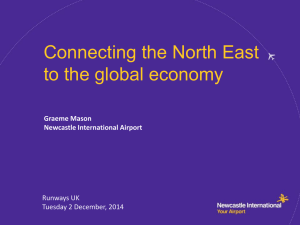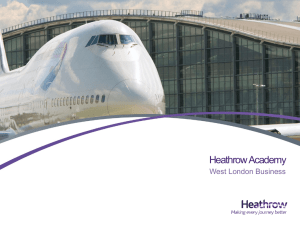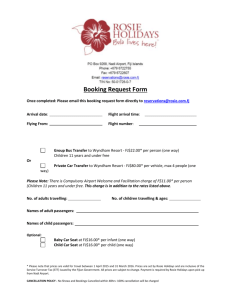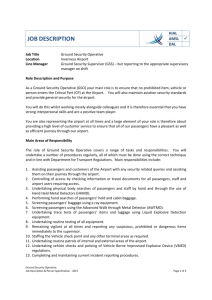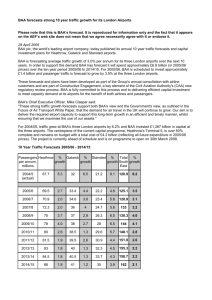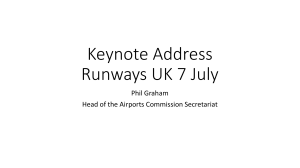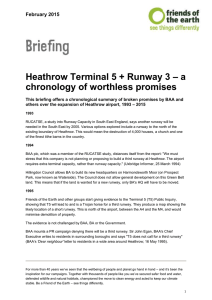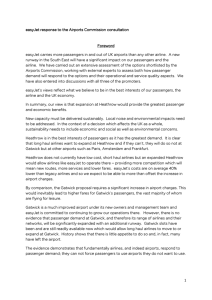Plane crazy: The costs of flying
advertisement
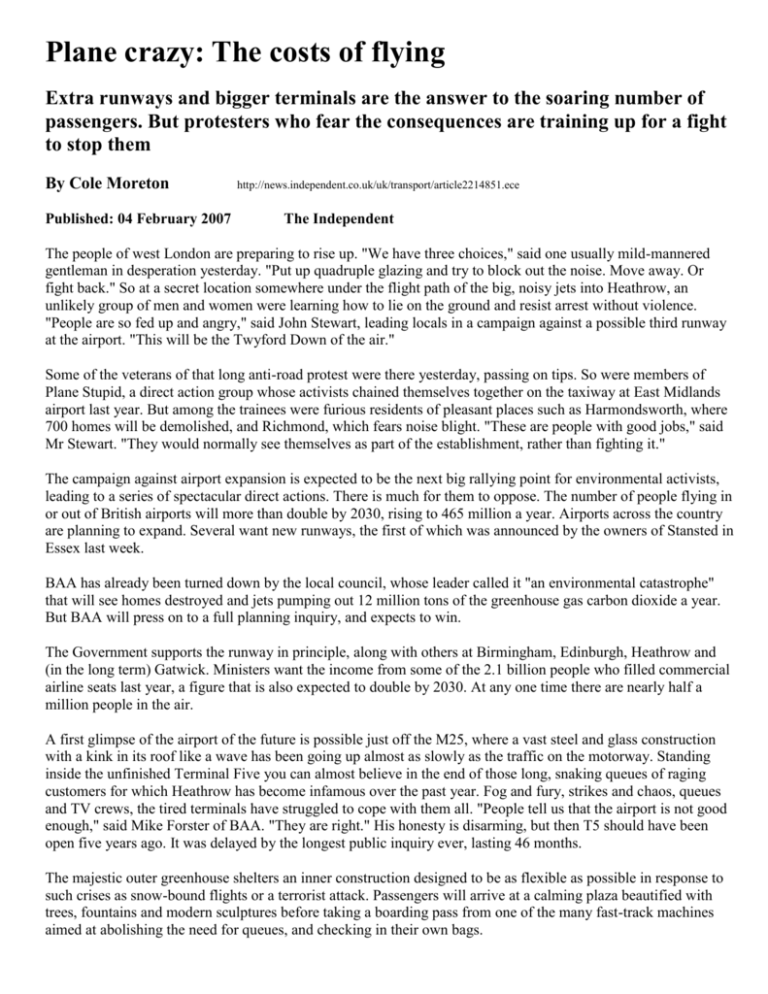
Plane crazy: The costs of flying Extra runways and bigger terminals are the answer to the soaring number of passengers. But protesters who fear the consequences are training up for a fight to stop them By Cole Moreton Published: 04 February 2007 http://news.independent.co.uk/uk/transport/article2214851.ece The Independent The people of west London are preparing to rise up. "We have three choices," said one usually mild-mannered gentleman in desperation yesterday. "Put up quadruple glazing and try to block out the noise. Move away. Or fight back." So at a secret location somewhere under the flight path of the big, noisy jets into Heathrow, an unlikely group of men and women were learning how to lie on the ground and resist arrest without violence. "People are so fed up and angry," said John Stewart, leading locals in a campaign against a possible third runway at the airport. "This will be the Twyford Down of the air." Some of the veterans of that long anti-road protest were there yesterday, passing on tips. So were members of Plane Stupid, a direct action group whose activists chained themselves together on the taxiway at East Midlands airport last year. But among the trainees were furious residents of pleasant places such as Harmondsworth, where 700 homes will be demolished, and Richmond, which fears noise blight. "These are people with good jobs," said Mr Stewart. "They would normally see themselves as part of the establishment, rather than fighting it." The campaign against airport expansion is expected to be the next big rallying point for environmental activists, leading to a series of spectacular direct actions. There is much for them to oppose. The number of people flying in or out of British airports will more than double by 2030, rising to 465 million a year. Airports across the country are planning to expand. Several want new runways, the first of which was announced by the owners of Stansted in Essex last week. BAA has already been turned down by the local council, whose leader called it "an environmental catastrophe" that will see homes destroyed and jets pumping out 12 million tons of the greenhouse gas carbon dioxide a year. But BAA will press on to a full planning inquiry, and expects to win. The Government supports the runway in principle, along with others at Birmingham, Edinburgh, Heathrow and (in the long term) Gatwick. Ministers want the income from some of the 2.1 billion people who filled commercial airline seats last year, a figure that is also expected to double by 2030. At any one time there are nearly half a million people in the air. A first glimpse of the airport of the future is possible just off the M25, where a vast steel and glass construction with a kink in its roof like a wave has been going up almost as slowly as the traffic on the motorway. Standing inside the unfinished Terminal Five you can almost believe in the end of those long, snaking queues of raging customers for which Heathrow has become infamous over the past year. Fog and fury, strikes and chaos, queues and TV crews, the tired terminals have struggled to cope with them all. "People tell us that the airport is not good enough," said Mike Forster of BAA. "They are right." His honesty is disarming, but then T5 should have been open five years ago. It was delayed by the longest public inquiry ever, lasting 46 months. The majestic outer greenhouse shelters an inner construction designed to be as flexible as possible in response to such crises as snow-bound flights or a terrorist attack. Passengers will arrive at a calming plaza beautified with trees, fountains and modern sculptures before taking a boarding pass from one of the many fast-track machines aimed at abolishing the need for queues, and checking in their own bags. All this has nothing to do with a new runway, which is at least a decade away if it is ever allowed at all. For now Heathrow is operating at more than 98 per cent of its legal and physical capacity, with planes coming or going every 90 seconds. With T5 the airport will take 90 million passengers a year, but Mr Forster fears they'll go elsewhere unless Heathrow raises its game. "This will be a world-class, stress-free space reflecting what aviation is about. We want some of that grandeur, some of that 'wow' factor. You're in natural light throughout your journey. You can see the planes outside with their noses pointing up to the glass." For now T5 is like the villain's lair in a James Bond film: a futuristic building on an epic scale, with shiny fittings, flashing lights and countless men in hard hats stomping about as if their quiet purpose is about to be disturbed by machine gun fire. But the fight - and there are several going on - is elsewhere. Outside, a British Airways jumbo rises from the north runway, its long-haul passengers £40 richer than most because BA paid their share of the extra tax imposed by the Chancellor from last week. Other airlines asked for cash at check-in. One group of carriers pointed out that jets have got cleaner and air travel is responsible for just 1.6 per cent of global CO2 emissions - and said aviation was used as "a punchbag in the environmental debate". You ain't seen nothing yet, says Joss Garman of Plane Stupid, which wants a ban on airport expansion and shorthaul flights. "Almost 60 per cent of UK flights are to places less than 500km away. That is ridiculous and obscene." And hugely popular. Flying to Paris from London creates at least 10 times more CO2 than going by Eurostar, but it is still the number one destination from Heathrow. Planes seem quicker and cheaper than overcrowded trains and we love them, however dirty. Government attempts to offset the CO2 with carbon trading schemes across Europe and the world have come to nothing so far - not least because nobody can decide who should pay for the damage when you fly between countries. Britain is committed to reducing its CO2 by 60 per cent in the next half a century, but international flights are not included in that target. Ministers are caught. They want less pollution, but more flights. Joss Garman will get up a lot of important noses if he does ever fight the battle of Harmondsworth, but the co-founder of Plane Stupid shows some plain sense in describing the dilemma we face. "Our aviation policy and our environmental policy are incompatible," he said. "It's our ability to live in Tuscany at the weekends versus our ability to go on living on the Earth at all." Growing airports The 228 million people who use UK airports every year will rise to 465m by 2030. New projects to cater for them include: Heathrow £4bn fifth terminal. May seek planning permission for third runway; 67 million passengers a year now, 116 million by 2030. Gatwick Expansion is forbidden before a review in 2019 but a second runway may follow; 33m passengers now, 80m (with new runway) by 2030. Stansted Seeking permission for second runway, at cost of £2.2bn; 22m passengers a year now, 68m by 2030. Southampton Potential new terminal, cost unknown; 2m people now, 6m by 2030. Glasgow New pier and extension to main terminal, cost £290m; 8.8m passengers now, 24m by 2030. Edinburgh New terminal, taxiways, possible runway, cost £300m; 8.8m passengers now, 26m by 2030. Aberdeen Longer runway, bigger terminal, cost £60m; 3m now, 5.9m by 2030. These airports are operated by BAA. The Government also supports expanded terminals at Belfast International, Cardiff, Dundee, Exeter, Luton, Manchester and Prestwick, plus the same with longer runways at Bristol, Inverness, Leeds-Bradford, Liverpool John Lennon, Newcastle and Teesside, and a second runway at Birmingham. AROUND THE WORLD Baiyun and others, China 49 new airports, £9bn to fly 2bn people a year Charles de Gaulle, France Rebuilding terminals, £21m, up to 60m people a year Johannesburg, South Africa Expansion, £813m, up to 21m for 2010 World Cup Frankfurt, Germany Expansion and runway, £2.2bn, rising to 80m passengers Lima Jorge Chavez, Peru Runway and terminal, £711m quadrupling to 22m Bangalore, India Airport opening 2008, £150m, starting with 11m passengers Madrid Barajas, Spain Expansion cost, £1.9bn, doubling to 70m passengers Bangkok Suvarnabhumi, Thailand Four-runway airport, cost unknown. Will carry 100m passengers a year Moscow Domodedovo, Russia Expansion cost, £305m. Doubling to 30m passengers Las Vegas McCarran, US Runways, buildings, £914m, growing from 35m to 53m people Incheon, South Korea Four-runway airport, £2.54bn, rising to 100m passengers Dubai International, UAE Expansion, £1.24bn, rising from 22m to 100m
